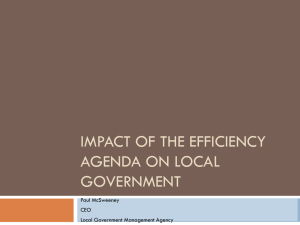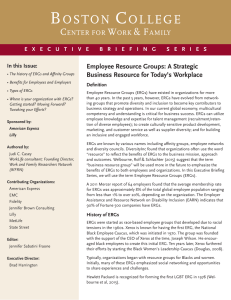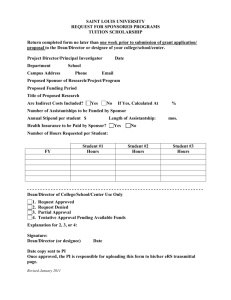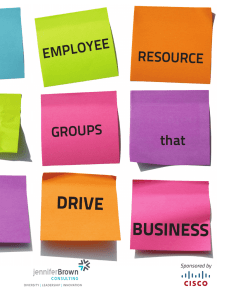Using Employee Resource Groups to Increase Diversity
advertisement
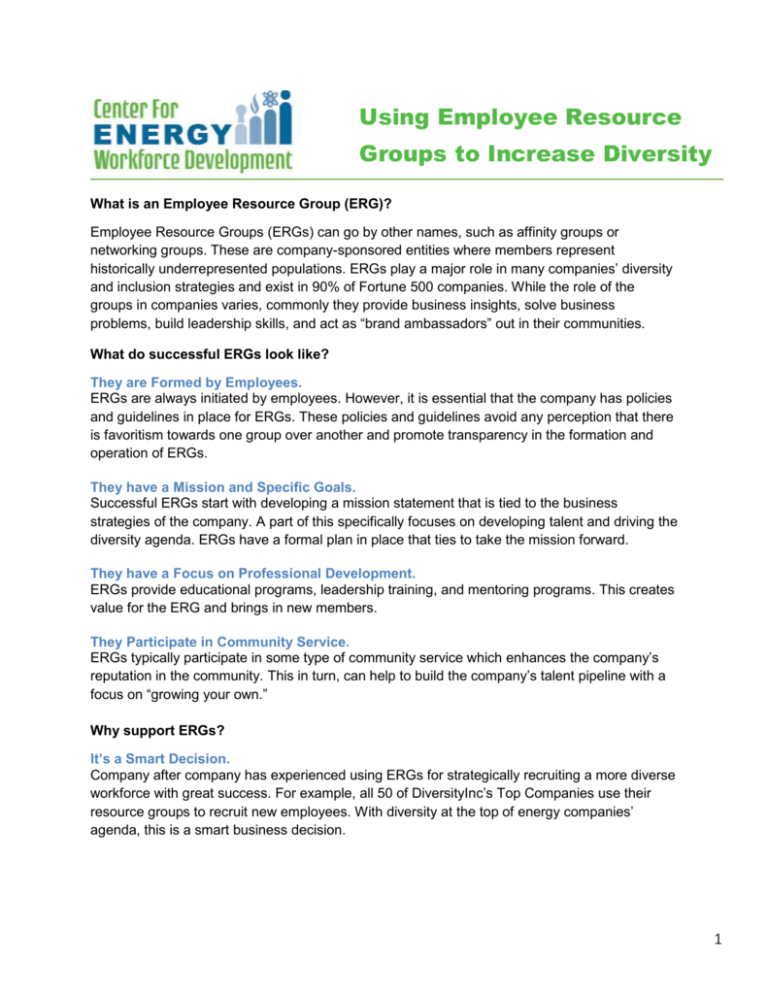
Using Employee Resource Groups to Increase Diversity What is an Employee Resource Group (ERG)? Employee Resource Groups (ERGs) can go by other names, such as affinity groups or networking groups. These are company-sponsored entities where members represent historically underrepresented populations. ERGs play a major role in many companies’ diversity and inclusion strategies and exist in 90% of Fortune 500 companies. While the role of the groups in companies varies, commonly they provide business insights, solve business problems, build leadership skills, and act as “brand ambassadors” out in their communities. What do successful ERGs look like? They are Formed by Employees. ERGs are always initiated by employees. However, it is essential that the company has policies and guidelines in place for ERGs. These policies and guidelines avoid any perception that there is favoritism towards one group over another and promote transparency in the formation and operation of ERGs. They have a Mission and Specific Goals. Successful ERGs start with developing a mission statement that is tied to the business strategies of the company. A part of this specifically focuses on developing talent and driving the diversity agenda. ERGs have a formal plan in place that ties to take the mission forward. They have a Focus on Professional Development. ERGs provide educational programs, leadership training, and mentoring programs. This creates value for the ERG and brings in new members. They Participate in Community Service. ERGs typically participate in some type of community service which enhances the company’s reputation in the community. This in turn, can help to build the company’s talent pipeline with a focus on “growing your own.” Why support ERGs? It’s a Smart Decision. Company after company has experienced using ERGs for strategically recruiting a more diverse workforce with great success. For example, all 50 of DiversityInc’s Top Companies use their resource groups to recruit new employees. With diversity at the top of energy companies’ agenda, this is a smart business decision. 1 It’s About Pride. Energy companies take great pride in their companies, in their communities, and in the customers they serve. ERGs typically engage in service projects in their communities. This is a way to showcase this pride. In addition, members of ERGs spread the word about the company being an inclusive place to work, therefore enhancing the company’s ability to attract a diverse workforce. It’s About Security. Affordable, reliable energy is crucial to the American economy. As the country’s demand for energy continues to increase, a strong workforce is critical to meeting future energy needs and to supporting economic growth and securing our assets. ERGs not only can be used to attract a strong workforce, but retain them as well. They provide a way for various cultural groups to feel connected and provide mentorship opportunities. It’s About Opportunity. As current employees retire, the energy industry has an incredible opportunity to build a new workforce—one that represents the communities they serve. Increasingly, companies are using ERG for recruiting a more diverse workforce. Examples of this include: ERG members can attend job fairs, networking events and provide testimonials on the company’s recruitment site. ERG members can meet with potential recruits and share how diversity and inclusion is valued by the company. ERGs can partner with HR to develop targeted recruitment strategies for underrepresented populations. How can the company best support ERGs? Have Policies in Place for ERGs. Written policies on ERGs promote transparency and avoid the potential of employees to claim favoritism towards one group over another. Such policies would include areas such as philosophy and purpose, why the company supports ERGs, recognition and endorsement, executive sponsorship, and funding. Provide an Executive Sponsor. Though ERGs are initiated by employees, identifying an Executive Sponsor is crucial to their success. Examples include the CEO, CFO, COO, President, or a Vice President. Allow Groups to Meet During Company Time. Many companies allow groups to meet during work hours, or if during off hours, pay hourly and salaried employees. 2 Provide Company Facilities for the Groups to Meet. A company can endorse a group by allowing it to meet in a company conference room or other common area. A company can also make company technology available to help overcome obstacles of space or time. Be Willing to Support the Groups with Resources they need to be Successful. ERGs should receive their funding based on their annual action plan, which would include a budget. This should be approved by the diversity function within the company. 3 Below is a Toolkit that can be provided to employees to help with launching and managing ERGs. This toolkit is from the Employer Assistance and Resource Network (EARN), part of the National Employer Technical Assistance Center. www.askearn.org. GETTING STARTED STEP 1: Start at the Top and Gain the Support of Corporate Executives ERGs are company-sponsored entities comprised of employees who have at one time felt underrepresented in the workplace. Although these groups are typically initiated by employees, it is critical to gain top management support and to identify an Executive Sponsor. From the beginning, interested employees should reach out to top-level management, such as a Chief Executive Officer (CEO), Chief Financial Officer (CFO), Chief Operating Officer (COO), President, Vice President or other corporate leaders who may have a specific interest in the mission of the group. Companies utilize different strategies for assigning Executive Sponsors. For example, at Verizon, Executive Sponsors are chosen by the Employee Resource Group while at Ford, each group is assigned one. Merrill Lynch also assigns its Executive Sponsors and rotates them every three years to ensure that they are exposed to as many employees as possible. Additionally, many companies make it a point to designate an Executive Sponsor who is not a member of that interest group. At this stage the following actions should be taken: Create a business case for the Employee Resource Group Articulate a mission statement which is tied to a business objective Draft a tentative plan to accomplish your goals Prepare a preliminary budget Secure executive sponsorship Share the group's objectives with employees and management Establish a leadership team Communicate to staff that member enrollment is voluntary STEP 2: Create Partnerships with Existing Internal Diversity Teams The new ERG should network and partner with internal diversity groups already in place at the organization. Request permission to attend meetings or to meet with the Executive Sponsor and group representatives to share your ideas, obtain feedback, and build relationships. Find out: How the group was started? Who they reached out to and how? What steps were taken to seek approval? What obstacles may have been encountered along the way? How were those obstacles managed? When and how often are meetings held? What are the typical meeting agendas? 4 STEP 3: Get Employees Involved ERG leaders should draw up a plan and work with their team to develop outreach strategies and generate interest for joining the group. The following steps are suggested to reach this objective: Develop materials to introduce the group Advertise the Employee Resource Group through: Company newsletters, e-mail blasts, company Intranet site, flyer inserts with paychecks, events, such as a welcoming breakfast, ads on interoffice note-boards, and networking with staff. STEP 4: Develop Budget and Secure Funding Once the goals of the ERG are established and agreed upon, prepare a budget that would support implementation and submit it to the Executive Sponsor. Since this individual represents upper management, he or she may be in the best position to advocate for the group and to secure the funding needed to carry out its stated mission and goals. In order for the group to be perceived as part of the organization, it is critical to obtain financial support. Information compiled from leading companies indicates that most allocate funds for their own ERGs. However, it is advisable to consider other methods of funding. These may include: Employee membership fees Funding from the company's national diversity budget Funding from representative departments Funding from annual grants provided by the Human Resource Diversity Department IMPLEMENTATION STEP 5: Name the Group The name of the ERG should reflect the group's mission and values and should be decided upon collaboratively. Making this decision may include: Soliciting name recommendations from the group Having a meeting to discuss ideas or an alternative method for making suggestions Choosing a name that reflects the purpose or values of the group Ensuring that this name clearly communicates the mission of the group and is interesting enough to make someone want to learn more or join 5 STEP 6: Set Mission and Goals The mission and goals should be established in collaboration with all ERG members and be linked to specific business goals. Together, they should communicate both the organization and the group's core values and common interest. While the mission defines the overarching purpose for which the group was established, the goals should clearly articulate specific activities and timelines. The following questions should be addressed when setting the mission and goals: What are the core values of the group? How is this group different from other groups in the company? What steps need to be taken to achieve the group's mission? What are the short and long term goals? What resources are needed for each goal? Who will take the lead in the implementation of each goal? What are reasonable and achievable timelines? STEP 7: Design Structure The structure and meeting schedule should be decided by the group with the input and support of the Executive Sponsor. Below are suggested steps for organizing the group's structure and meeting schedule: Determine the day, time, length, and frequency of meetings Create an alternate plan for those who may not be able to attend in person (e.g., teleconferences) Select a location Consider specific roles for members List the roles and discuss with the group o Designate member(s) to: Lead meetings Create meeting agendas Share agendas with members prior to meetings Send reminders to members and staff regarding the meeting place and time (ensure locations are accessible for individuals with disabilities) Receive responses and track attendance Take notes and send minutes before the next meeting STEP 8: Create an Innovative Business Solution Identifying a special feature for the program is critical to generating interest, fostering participation, and enhancing attendance. Defining this special feature in the context of a business solution creates added value and increases support and recognition for the group. For example, setting a goal to establish a cadre of mentors to guide newly hired persons with 6 disabilities or for employees or caregivers who manage newly diagnosed impairments may significantly improve productivity and job retention. Community involvement is another goal with high visibility that may enhance the company's external image with diverse groups and organizations. Serving on boards or participating in special events promotes overall brand recognition while establishing the company as an employer of choice, with the former contributing to increased market share and the latter to talent acquisition. Brainstorming with group members will help generate ideas that will give a unique focus and purpose for all to work towards. Following are a few steps for consideration in meeting this goal: Send out an invitation for a brainstorming session State the purpose of the session so members are prepared with ideas Set up an alternative for members who cannot attend to share ideas Assure members that all ideas will be considered and respected Record all concepts/ideas Group like concepts together Eliminate, through consensus, ideas that do not fit Have all members vote Adopt the consensus idea and disseminate company-wide STEP 9: Challenges If faced with challenges during development, implementation, or maintenance, identify the root causes and then take steps to reduce or eliminate them. As a group, members should take the following steps: Define the challenge Analyze the cause Explore solutions Decide whether the challenge is worth solving Take action to overcome the challenge Consider the necessary steps to avoid similar challenges Examples of challenges may include: Obtaining senior level support Recruiting employees Maintaining member participation Managing work schedules Addressing meeting conflicts Securing funding Dealing with lack of resources Increasing membership 7 STEP 10: Maintain Momentum Ongoing company and member support is vital to success. The ownership for maintaining the momentum resides with the entire group, including the Executive Sponsor. The following tips may be used to maximize efficacy and ensure continued momentum: Establish credibility by adhering to mission, objectives, and timelines Communicate the group's efforts utilizing all internal resources Continue building a network to increase enrollment Create visibility by conducting or participating in special events Respond to challenges and remove obstacles Suggested activities that may help to maintain momentum and sustainability can include: In-house networking events Workshops on topics related to the program (e.g., Lunch and Learn seminars, National Disability Employment Awareness Month celebrations, etc.) Engagement with outside agencies (e.g., volunteering, mentoring, serving on Boards, etc.) Monthly updates on program status Suggested In-house resources: Company newsletters (related articles, tips) Intranet website Notice boards E-mail blasts and blogs In-house T.V. streaming on the ERG's upcoming events and event highlights STEP 11: Leverage Relationships with Other Internal Resource Groups Employee Resource Groups are internal networks that represent a community of team members who share a common interest relating to such characteristics as ethnicity, gender, nationality, culture, disability or sexual orientation. These groups may form relationships with one another in order to gain additional visibility and increase impact. Ways to leverage relationships with other internal resource groups may include: Maintaining an ongoing partnership with the leadership of other groups Keeping open communication with members from these groups Exchanging or sharing information and resources Collaborating on community and professional events and activities Disseminating ERG announcements of news and upcoming events Sharing financial resources Reporting progress Sharing best practices Establishing partnerships with other business leaders that have a vested business interest in the group 8 STEP 12: Measure Success To measure success, the group first must establish goals and success criteria (benchmarking). These will ultimately define how the group has done and what it has delivered. The group's goals and success criteria should be easily understood, support the mission, and be measurable. Some success criteria for consideration may include: Recruiting 10 new members per year Publishing a quarterly newsletter Conducting one annual event Designing two group activities Increasing participant attendance at meetings and events CONCLUSION With a clear business focus, Employee Resource Groups can be strategic partners that contribute significantly to an organization's overall success and profitability. As with any effective business practice, ERGs must be carefully planned, well managed, and have clear and measurable outcomes. They have been most effective when senior management was involved and an Executive Sponsor was assigned to lend support and link the group's mission and work directly to business goals. Operating a successful ERG is an on-going process, which requires continuous nurturing, but the benefits derived are well worth the effort. 9 RESOURCES Employee Resource Groups 101 In this Diversity, Inc. video, David Casey, vice president and diversity officer at CVS Caremark, discusses the case for Employee Resource Groups and gives a step-by-step guide to setting up groups; including charters, employee engagement, and Veterans groups. Disability Employee Resource Groups This Diversity Journal article offers comprehensive information about Disability Employee Resource Groups; framing them as tremendous assets for companies that are able to connect the Group focus to the overall business goals and objectives of the company. Diversity Best Practices: Top Five Employee Resource Groups This Diversity Best Practices article describes the top 5 most popular Employee Resource Groups in the US. Disability Employee Resource Groups are a highly popular (ranking 5th nationwide), with 46% of companies surveyed offering this type of affinity group. Employee Resource Group Articles from DiversityInc. This links to a variety of articles and webinars on using ERGs to promote diversity. 10

